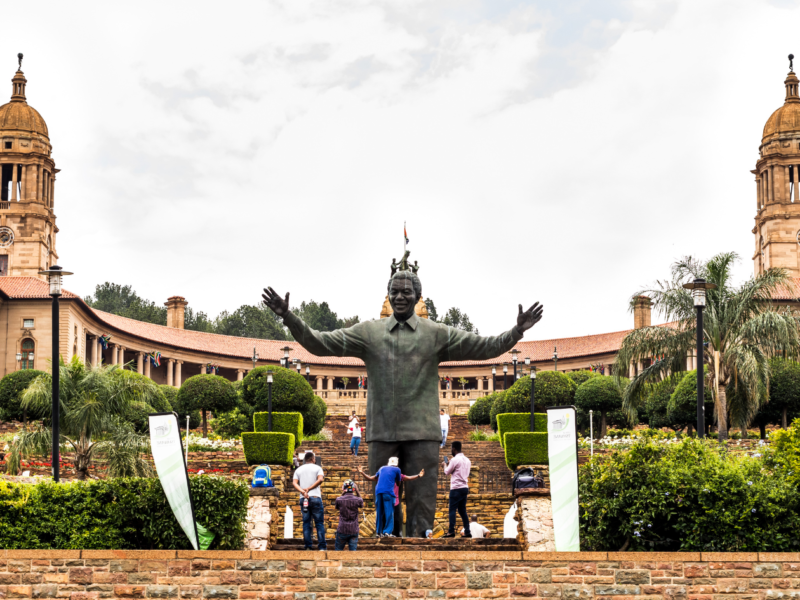South Africa, a country rich in history, culture, and natural beauty, is home to a myriad of famous landmarks that tell the story of its diverse heritage. From towering lighthouses to impressive monuments, these landmarks paints a vivid picture of the events, people, and struggles that have shaped South African into the nation it is today. Join us on a journey to explore historical landmarks in South Africa.
1820 Settlers National Monument
The 1820 Settlers National Monument, a historical landmark in South Africa, celebrates the British settlers’ arrival in 1820. Situated in Grahamstown, Eastern Cape, the monument was inaugurated in July of 1974. In 1994, a fire caused significant damage, prompting a reconstruction of the monument. In May 1996, Nelson Mandela officially rededicated the restored monument.
Afrikaans Language Monument
The Afrikaans Language Monument, or Afrikaanse Taalmonument, is a significant landmark located on a hill overlooking Paarl in the Western Cape Province of South Africa. The monument was officially opened on October 10, 1975, to commemorate the 50th anniversary of Afrikaans being declared an official language of South Africa, separate from Dutch.
The monument also marks the 100th anniversary of the founding of the Genootskap van Regte Afrikaners (the Society of Real Afrikaners) in Paarl, an organization that played a crucial role in strengthening the Afrikaners’ identity and pride in their language. The monument’s design comprises various tapering structures of a convex and concave nature, symbolizing the influences of different languages and cultures on Afrikaans.
Big Hole
The Big Hole, also known as the Kimberley Mine is a significant landmark from the diamond rush era. Located in Kimberley, South Africa, this open-pit and underground mine is claimed to be the deepest hand-dug excavations in the world, reaching a depth of 240 meters.
Its history dates back to 1871 when the first diamonds were discovered, sparking a rush of miners who, over the course of 43 years, excavated 2,720 kilograms of diamonds. Today, the Big Hole serves as a tourist attraction and a poignant reminder of Kimberley’s diamond mining past. Efforts have been underway since the early 2000s to register the Big Hole as a World Heritage Site.
Cape Agulhas Lighthouse
The Cape Agulhas Lighthouse stands tall at the southernmost tip of Africa. Constructed in 1849, it was the third lighthouse to be built in South Africa and remains the second-oldest still in operation. The lighthouse was decommissioned in 1968 due to the crumbling sandstone walls, but was restored and recommissioned in 1988.
Today, it is operated by the South African National Parks and has been recognized as an International Historic Civil Engineering Landmark by the American Society of Civil Engineers (ASCE) in 2016.
Castle of Good Hope
The Castle of Good Hope, known locally as the Castle or Cape Town Castle, is a bastion fort built in the 17th century in Cape Town, South Africa. It was constructed by the Dutch East India Company beginning in 1666, making it the oldest existing building in South Africa.
The Castle was built to act as a replenishment station for ships passing the treacherous coast around the Cape on long voyages between the Netherlands and the Dutch East Indies (now Indonesia).
The Castle of Good Hope was declared a historical monument in 1936 and is considered the best preserved example of a Dutch East India Company fort after extensive restorations in the 1980s. The Castle now houses the Castle Military Museum and ceremonial facilities for the traditional Cape Regiments.
Chancellor House
Chancellor House holds great historical significance in South Africa. It was once the residence of Nelson Mandela and the location of the first black law firm in the country, which he established alongside Oliver Tambo. Situated in the bustling heart of Johannesburg’s CBD, the building now serves as a museum and archive.
The Cenotaph
The Cenotaph in South Africa is a prominent war memorial located in Cape Town. It was erected after World War I to commemorate the soldiers who lost their lives during the conflict. The monument is a significant symbol of remembrance in South Africa, standing as a solemn tribute to the fallen. It’s located in the city’s central business district, making it a focal point for annual commemorative events.
Freedom Park
Freedom Park is a significant landmark situated on Salvokop in Pretoria, South Africa. The park serves as a memorial, listing the names of those who lost their lives in the South African Wars, World War I, World War II, and during the apartheid era. The park is not just a tribute to South African heroes but also recognizes international and continental leaders who contributed to the liberation of South Africa.
Groot Constantia
Groot Constantia, located in the suburb of Constantia in Cape Town, South Africa, is the oldest wine estate in the country. The term “Groot” translates to “great” in English, reflecting the estate’s significant size and reputation. The estate was granted to Simon van der Stel, the VOC Governor of the Cape of Good Hope, by Hendrik Adriaan van Rheede tot Drakenstein in 1685. Over the centuries, the estate has been known for its production of high-quality red wines and the Constantia dessert wine. Today, Groot Constantia is a provincial heritage site.
Horse Memorial
The Horse Memorial is a provincial heritage site in Port Elizabeth, in the Eastern Cape province of South Africa. It was erected in memory of the horses that served and died during the Second Boer War. The British brought a large number of horses to South Africa for the war, and it is estimated that more than 300,000 horses died in British service.
The memorial features a life-sized bronze statue of a kneeling soldier presenting a bucket of water to a service horse. The memorial was unveiled in 1905 and is a poignant tribute to the gallant animals that perished in the war. Despite its solemn purpose, the memorial was vandalized in 2015 by a group associated with the Economic Freedom Fighters, a far-left political party, as part of a broader campaign against colonial-era statues and memorials.
The Huguenot Monument
The Huguenot Monument in Franschhoek, South Africa, was built to honor the 250th commemoration of the first French Huguenots’ arrival in 1938. The monument represents the Huguenots’ pursuit of religious liberty. The monument features a statue of a young Huguenot woman, holding a Bible in her right hand and a broken chain in her left, symbolizing the essence of religious freedom. The monument stands against the backdrop of the Franschhoek Mountains in a garden landscape.
The Moorddrift Monument
The Moorddrift Monument, also known as the Murder Ford Monument, is a provincial heritage site located in Potgietersrus in the Limpopo province of South Africa. This monument is of significant historical importance, commemorating the murder of 28 settlers in the region in 1854. Despite its simplicity, the Moorddrift Monument stands as a poignant reminder of a tragic event in South Africa’s history.
Pretoria Forts
The Pretoria Forts, located in Pretoria, South Africa, are a series of forts built by the government of the South African Republic (ZAR) just before the outbreak of the Second Anglo-Boer War. The forts, which include Schanskop, Klapperkop, Wonderboompoort, and Daspoortrand, were constructed to protect the city from attacks.
The forts were designed by German architects and were considered military engineering masterpieces of the time. However, despite their strategic design and advanced weaponry, the forts were never used in battle during the war. Today, Schanskop and Klapperkop have been preserved as museums and are popular tourist attractions, offering insight into South Africa’s military history.
Rhodes Memorial
The Rhodes Memorial is a significant monument located on Devil’s Peak in Cape Town, South Africa. It was built in honor of Cecil John Rhodes, an English-born South African politician. The monument, designed by architect Herbert Baker, is situated at Rhodes’s favorite spot on the lower slopes of Devil’s Peak.
The memorial consists of a massive staircase with 49 steps, symbolizing each year of Rhodes’s life, leading up to a rectangular U-shaped monument formed of pillars. At the bottom of the steps is a bronze statue of a horseman. Despite its historical significance, the memorial has been a subject of controversy due to Rhodes’s political impact in the formation of an unequal system in South Africa.
Samora Machel Monument
The Samora Machel Monument in Mbuzini, South Africa, is a heartfelt memorial honoring the former President of Mozambique, Samora Machel, and a number of Mozambican ministers that were killed in a plane accident in 1986. The monument, which was inaugurated in January of 1999 and contains a portion of the plane’s wreckage. It is comprised of 35 steel tubes, representing the number of lives lost in the plane accident. In 2006, the site was declared a National Heritage Site.
Shaka Memorial
The Shaka Memorial is a provincial heritage site located in the KwaZulu-Natal province of South Africa. It marks the resting place of the Zulu King Shaka, a revered figured who had a significant impact on shaping the Zula culture. The monument was erected in 1932 on the site of King Shaka’s grave.
Adjacent to the memorial is a rock, which is believed to be the spot where King Shaka was sitting at the time of his assassination on 24 September 1828. This rock was moved from its original location to where it now lies. Every year, the date of King Shaka’s assassination is commemorated with a gathering at the memorial, led by the Zulu king, his warriors, and dignitaries.
Slangkop Lighthouse
The Slangkop Lighthouse, located near the town of Kommetjie, impressive cast-iron tower stands at a height of 33 meters, making it the tallest lighthouse on the South African coast. Since its first lighting in 1919, the lighthouse has faithfully guided ships, ensuring their safe passage along the coast. With its distinctive flashes of light, the white circular tower is a remarkable sight, especially when viewed against the backdrop of a setting sun.
Voortrekker Monument
The Voortrekker Monument, located in Pretoria, is a massive granite structure built to honor the Voortrekkers who left the Cape Colony (a British colony in present day South Africa named after the Cape of Good Hope) between 1835 and 1854. It’s a significant symbol of Afrikaner heritage. The monument was inaugurated on 16 December 1949.
The monument complex is a heritage site and includes a nature reserve and an outdoor amphitheater. Inside the monument, there are historical artifacts and a tapestry depicting the Great Trek, a mass movement of Dutch-speaking colonists up into the interior of southern Africa in search of land where they could establish their own homeland, independent of British rule.
Robben Island
Robben Island is a significant historical site located in Table Bay, off the coast of Cape Town, South Africa. The island is renowned for its maximum-security prison where anti-apartheid activists, including Nelson Mandela, were incarcerated. Mandela spent 18 of his 27 years in prison on the island.
The prison was notorious for its harsh conditions and the brutal treatment of prisoners. However, it was also a place where the ideals of freedom and equality were kept alive and even flourished. In 1997, the prison was closed, and in 1999, Robben Island was declared a UNESCO World Heritage Site.
Table Mountain
Table Mountain, a prominent landmark in South Africa, is a flat-topped mountain forming a prominent landmark overlooking the city of Cape Town. It is a significant tourist attraction, with many visitors using the cableway or hiking to the top. The mountain forms part of the Table Mountain National Park. Its rich biodiversity and unique flora have earned it recognition as a UNESCO World Heritage Site.
The mountain’s history is deeply intertwined with that of Cape Town, providing a backdrop to centuries of growth and development. It has spiritual significance to the local Khoisan people and was a navigational landmark for early European explorers. Today, Table Mountain stands not only as a natural wonder but also as a symbol of South African heritage and pride.

“Traveling is the art of collecting stories, not just souvenirs.”
